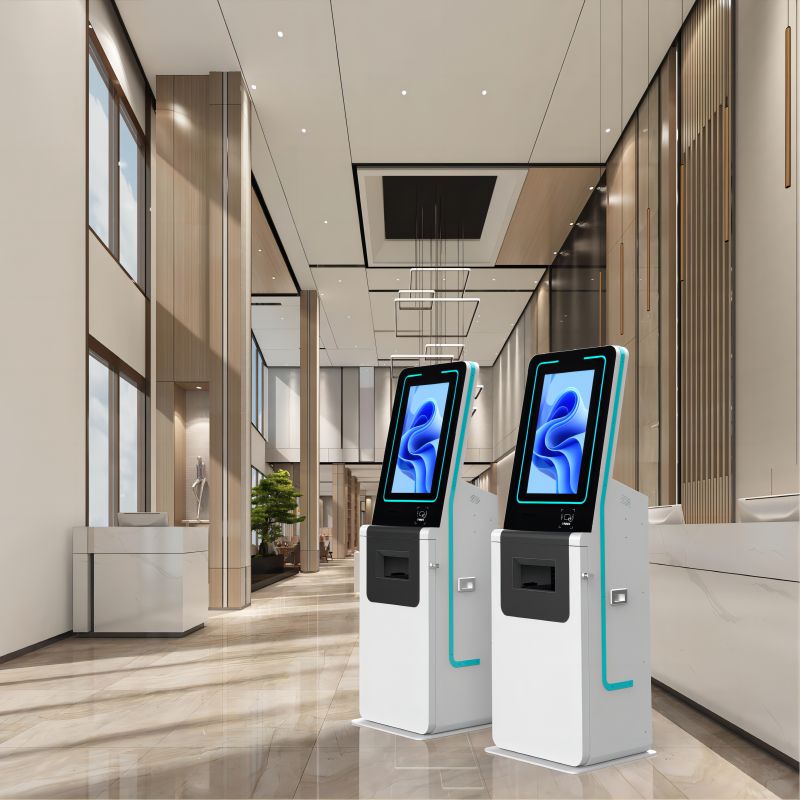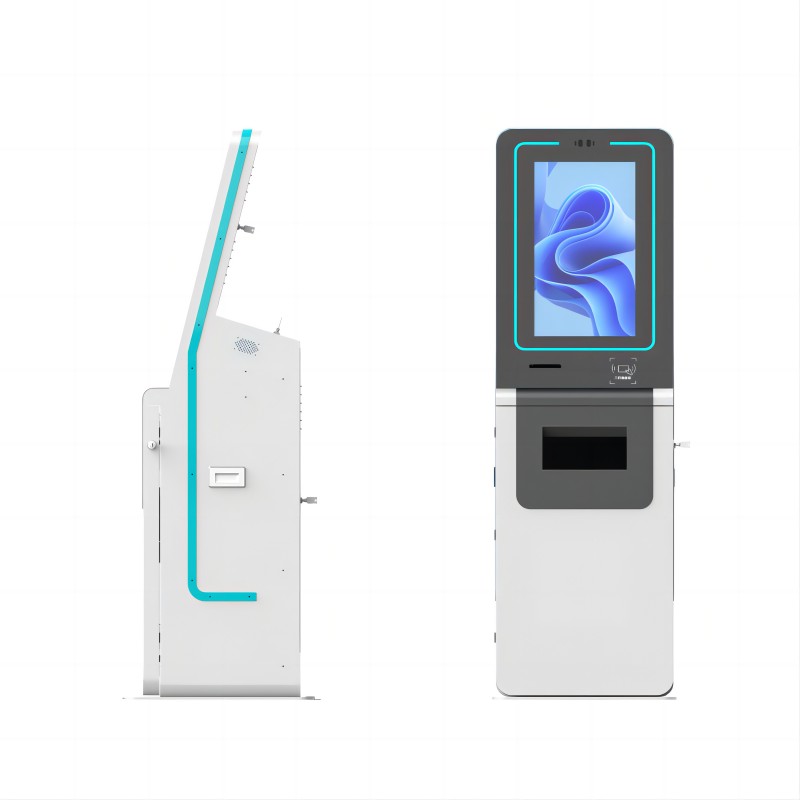





Airports today are facing rising passenger volumes, and the need for automation is greater than ever. Self-check-in kiosks have emerged as essential tools for streamlining passenger processing, reducing queues, and enhancing the overall travel experience. These kiosks allow passengers to check in, print boarding passes, and tag their own luggage—all without needing to wait in line for assistance from airline staff. This technology not only optimizes operational efficiency but also offers contactless and faster processing, which is especially important in a post-pandemic world.
With this increasing reliance on automated services, understanding the setting and description: setting: airport description: self-check-in kiosk has become crucial for airport operators and travelers alike.
A self check in kiosk is a digital terminal typically located in airport to facilitate quick and efficient passenger check-in. self-check-in kiosk offers a variety of services, including printing boarding passes, checking flight status, baggage tagging, and even making payments for additional services such as extra baggage or seat upgrades.
Airports worldwide are implementing these self-check-in kiosks as part of their automation strategies, allowing for faster processing of passengers and reduced operational costs.
Self-service functionality
Integration with airline databases
Intuitive touch interfaces
Baggage tagging and seat selection capabilities

Touchscreen Displays: Offering an easy-to-use interface for passengers, typically sized between 21.5 inches to 27 inches, with resolutions such as 1920x1080 for clear visuals.
Document Scanners: Includes passport and ID card scanners for identity verification.
Payment Options: Integrated systems that allow contactless payments, useful for additional services like extra baggage or premium seating.
Mobile Boarding Pass Integration: Some kiosks allow scanning of mobile boarding passes to streamline the process.
The advantages of implementing self-check-in kiosks in airports include:
Increased Efficiency: Passengers can check themselves in and print boarding passes without waiting in line for a customer service representative.
Cost Savings: Airports and airlines benefit from reduced labor costs, as fewer staff are required to manage the check-in process.
Enhanced Passenger Experience: Travelers enjoy a faster, streamlined process, which improves overall satisfaction.
Contactless Operation: Minimizing the need for human contact, self-check-in kiosks are a key component in ensuring hygiene and safety in airports.
elf check in kiosk has become an essential tool for airports aiming to streamline operations and enhance passenger experience. This kiosk has a wide range of applications that cater to both airport management and traveler convenience.
Passenger Check-In: The primary application of self-check-in kiosks is enabling passengers to check in for their flights independently. These kiosks allow travelers to select or change seats, confirm details, and print boarding passes, reducing wait times and easing congestion at check-in counters.
Baggage Tagging: Many self-check-in kiosks come equipped with the ability to print baggage tags, allowing passengers to tag their own luggage before dropping it off at designated counters. This speeds up the baggage handling process and reduces human errors.
Flight Information Access: Passengers can use kiosks to view flight schedules, updates on delays, gate changes, and other real-time flight information. This minimizes confusion and improves the flow of communication in busy airport environments.
Payments for Additional Services: Self-check-in kiosks often integrate payment options, allowing travelers to pay for extra services like additional baggage, seat upgrades, and priority boarding, streamlining these transactions without requiring assistance from airport personnel.
Mobile Boarding Pass Scanning: Kiosks support the scanning of mobile boarding passes, allowing passengers who checked in online to verify their identity and reprint passes if needed.
Passport and Visa Verification: With integrated document scanners, these kiosks can verify passenger identity by scanning passports, visas, and other required documentation, providing an extra layer of security.

Customizing a self-check-in kiosk to fit an airport’s unique needs enhances operational efficiency, improves branding, and meets passenger expectations. Here are some key customization options:
Screen Size: Common screen sizes range from 21.5 inches to 27 inches, allowing flexibility depending on the available space and user preference.
Biometric Scanners: For additional security, biometric scanners can be added for facial recognition or fingerprint verification, aligning with modern airport security protocols.
Baggage Tag Printers: Airports can include high-performance printers that print durable, legible baggage tags quickly and accurately.
Contactless Payment Terminals: Integrated NFC technology for contactless payments allows passengers to pay for additional services without handling cash or credit cards.
Multilingual Keyboards: Physical keyboards or touchscreen inputs can be customized to support multiple languages, catering to international travelers.
Durability Features: Customizing for high traffic and harsh airport environments, kiosks can include durable materials, vandal-resistant screens, and high-quality build standards to withstand continuous use.
Multilingual Support: Custom software can be configured to offer multilingual options, accommodating international travelers by providing instructions and prompts in multiple languages.
Airline Integration: The software can be tailored to seamlessly integrate with specific airline reservation systems, offering a unified experience across different airlines within the same airport.
Branding Customization: The user interface can be designed to feature the airport’s or airline’s branding, including logos, color schemes, and fonts, enhancing brand visibility.
Custom Reporting Tools: Software can be developed to provide real-time analytics on passenger check-in statistics, flight delays, and kiosk usage, helping airport authorities monitor operations.
Data Encryption: Ensuring that all passenger data is encrypted during transactions, both for check-in and payments.
Biometric Integration: Enhanced security measures, such as facial recognition or fingerprint scanning, can be incorporated to streamline security processes without compromising safety.
ADA-Compliant Design: Custom kiosks can be designed with features that cater to passengers with disabilities, including adjustable height screens, voice-guided instructions, and larger, more accessible touchscreens.
Multi-Language Audio Support: For visually impaired passengers, audio instructions in various languages can be included to guide users through the check-in process.
Installing and setting up a self-check-in kiosk at an airport involves several key steps to ensure the device operates efficiently and meets security, accessibility, and functional requirements. Below is a detailed guide on installation and setup:
Location Selection: Choose a high-traffic area within the terminal, close to entrance points or check-in areas. Ensure the space is easily accessible and well-lit.
Power and Connectivity: Ensure that electrical outlets and network connections (Wi-Fi or wired Ethernet) are available. Airports may require secure, encrypted networks to comply with security protocols.
Environmental Conditions: If kiosks are placed outdoors or in areas with fluctuating temperatures, consider environmental controls like temperature regulation and protective casings.
Mounting: Depending on the design (free-standing, wall-mounted, or countertop), securely mount the kiosk to prevent theft or damage.
Power Setup: Connect the kiosk to a stable power source with backup options in case of power failures.
Network Integration: Connect the kiosk to the airport’s network system for secure communication with airline databases and passenger management systems.
Airline Integration: Configure the kiosk to integrate with airline databases and other systems such as payment gateways and baggage management.
User Interface Setup: Customize the UI based on the airport or airline's branding, incorporating languages and functionalities suitable for the target audience.
Security Features: Set up encryption protocols, data privacy measures, and secure communication between the kiosk and central servers to protect passenger data.
Functionality Tests: Test all the kiosk's key functions, including check-in, baggage tag printing, payment processing, and document scanning, ensuring smooth operations.
Connectivity Checks: Ensure stable internet and power connections to prevent downtime.
Accessibility Testing: Test ADA-compliant features like height adjustment, voice commands, and support for visually impaired passengers.

Using a self-check-in kiosk at the airport is simple and designed to expedite the check-in process. Here’s a step-by-step guide:
Start the Process: Approach the kiosk and follow the on-screen instructions. The home screen will typically have multiple language options.
Scan Passport or Enter Booking Info: You may be asked to scan your passport or input your booking reference number, loyalty program details, or credit card for identity verification.
Select Flight: Confirm your flight details and the number of passengers traveling.
Choose Seating: Many kiosks offer the option to select or change seats if not already assigned.
Print Boarding Pass: Once the check-in process is complete, the kiosk will print your boarding pass.
Baggage Tagging: If you have checked luggage, the kiosk may print baggage tags that you can attach to your luggage before proceeding to the baggage drop area.
Complete and Proceed: After receiving your boarding pass and luggage tags, proceed to the security or baggage drop area.
Remote and On-Site Technical Support: 24/7 Remote Monitoring: We provide real-time system monitoring to detect and address issues remotely, minimizing downtime.
On-Site Repairs: In case of hardware malfunctions, we offer on-site repair services to ensure quick resolution.
Regular Software Updates: We release regular software updates to keep your kiosk systems current with the latest technology, security patches, and new functionalities.
Warranty and Maintenance: We offer extended warranty options, covering both hardware and software components. Preventative maintenance checks ensure kiosks continue running smoothly without interruptions.
Training and User Guides: Detailed training is provided for airport staff, covering the operational and troubleshooting aspects of the kiosks, allowing smooth day-to-day operations.
Spare Parts Availability: We ensure a ready stock of spare parts for quick replacements when necessary, ensuring minimal disruption to airport services.
Self-check-in kiosks utilize advanced encryption protocols and secure scanning technologies to safeguard personal and travel data. This includes secure data transmission between the kiosk, airline servers, and payment processors, ensuring passenger information remains private and protected from potential breaches.
Most self check in kiosks support a wide range of payment options, including contactless payments (like NFC and RFID), traditional credit/debit cards, and mobile payment methods such as Apple Pay or Google Pay. These flexible payment systems enhance convenience and speed for passengers.
Yes, self check in kiosk can be fully customized to align with the airport’s or airline’s branding. Customization options include color schemes, logos, interface layouts, and even language preferences, offering a seamless experience that reflects the airport or airline's identity.
Self-check-in kiosks are designed with user experience in mind. They feature large, high-resolution touchscreens, clear instructions, and intuitive interfaces to ensure even first-time users can easily navigate the check-in process. Multilingual support further enhances accessibility for international passengers.
The installation cost of self check in kiosks varies depending on several factors: the level of customization, the number of kiosks needed, and the location. Other considerations include the kiosk hardware, software licenses, and payment system integrations. Costs may range from $5,000 to $25,000 per kiosk, depending on these variables.
Installing self-check-in kiosks usually takes between 1-2 weeks, depending on the complexity of the site preparation (e.g., electrical, network setup) and the number of kiosks being installed. This timeline includes both hardware setup and software configuration.
In the event that a self-check-in kiosk goes offline, most systems are equipped with remote diagnostics and monitoring tools, allowing technical support to address issues quickly. Additionally, many kiosks are designed with backup systems to ensure minimal disruption, allowing basic functions to remain operational even during network downtime.
Self-check-in kiosks are designed with accessibility in mind. Features include adjustable screen heights, text-to-speech capabilities for visually impaired passengers, and easy-to-read interfaces. Kiosks are also equipped with multilingual support to cater to passengers of different nationalities, ensuring ease of use for all travelers, including those with disabilities.
Address: No. 99-15, Fuan intelligent manufacturing Industrial Park, Dayang Road, Fuhai Street, Baoan District, Shenzhen, China